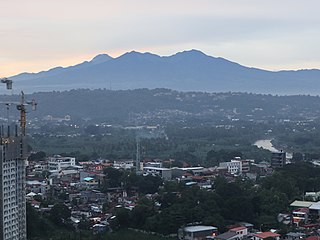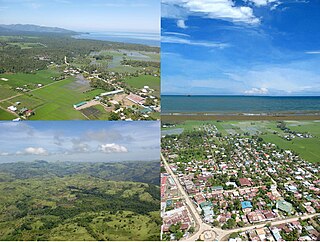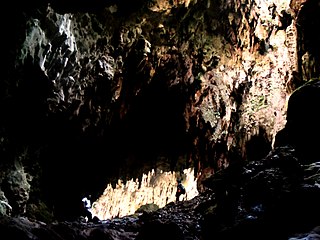
Mount Apo, also known locally as Apo Sandawa, is a large solfataric, dormant stratovolcano on the island of Mindanao, Philippines. With an elevation of 2,954 meters (9,692 ft) above sea level, it is the highest-mountain in the Philippine Archipelago, Mindanao and 24th-highest peak of an island on Earth. Located on the tripartite border of Davao City and Davao del Sur in the Davao Region, and Cotabato in Soccsksargen, Mount Apo is the most-prominent mountain in the Philippines. The peak overlooks from Davao City 45 kilometers (28 mi) to the northeast, Digos 25 kilometers (16 mi) to the southeast, and Kidapawan 20 kilometers (12 mi) to the west. It is a protected area and a Natural Park of the Philippines.

Lebak, officially the Municipality of Lebak, is a 1st class municipality in the province of Sultan Kudarat, Philippines. According to the 2020 census, it has a population of 88,868.

Datu Odin Sinsuat, officially the Municipality of Datu Odin Sinsuat, is a 2nd class municipality and capital of the province of Maguindanao del Norte, Philippines. According to the 2020 census, it has a population of 116,768 people.

Callao Cave is one of 300 limestone caves located in the Barangays of Magdalo and Quibal in the municipality of Peñablanca, about 24 km (15 mi) northeast of Tuguegarao City, the capital of Cagayan province within the Peñablanca Protected Landscape and Seascape in the western foothills of the Northern Sierra Madre Mountains on Luzon island in the Philippines. The town Peñablanca's name refers to the predominance of white limestone rock formations in the area. First excavated in 1980 by Maharlika Cuevas, the seven-chamber show cave is the best known natural tourist attraction of the Cagayan province and in February 2020 has officially been recognized as an important cultural property of the Philippines.

Mount Malindang is a complex volcano located in the province of Misamis Occidental in the southern island of Mindanao, Philippines. It is the highest point in the province. The least studied mountain range was formed through several volcanic activities some of which could be historical, evident by the presence of two calderas, surrounded by high rock walls, cinder cones, dome volcano plugs, two sulfurous hot springs, and a crater lake named Lake Duminagat. The amphitheater structures have extensive distribution of volcanic rocks, carbonized wood that are found in pyroclastic deposits. The mountain range is dissected by several canyons and ravines.
The Northern Luzon Heroes Hill National Park is a national park in the Republic of the Philippines, located in the municipalities of Santa and partly in Narvacan in Ilocos Sur province. The protected area was established on July 9, 1963, by Proclamation No. 132.
Sacred Mountain National Park is a national park in Marawi, Lanao del Sur in the Southern Philippines. The 94-hectare (230-acre) national park and protected area, located in Brgys. Guimba and Papandayan, was established on August 5, 1965, by Republic Act no. 4190. The main geographic feature of the park is Mount Mupo which has the height of 274.32-meter (900.0 ft). Activities in the park include birdwatching and trekking to the mountaintop where a pond is located.
Aurora Memorial National Park is a protected area of the Philippines located within the Sierra Madre mountain range between the provinces of Nueva Ecija and Aurora in Central Luzon. The Aurora Memorial National Park covers an area of 5,676 hectares stretching over 50 kilometers along the scenic Bongabon-Baler road. Established in 1937 by virtue of Proclamation No. 220, the park initially had an initial area of 2,356 hectares. By 1941, its size was more than doubled to its current area of 5,676 hectares. The park was subsequently dedicated to former First Lady Aurora Aragon Quezon in May 1949. The maximum altitude of the park is reported to be 1,000 m, so the main forest type inside the park must be lowland dipterocarp, with only limited areas of montane forest. Land uses inside the park include both permanent and shifting agriculture (kaingin) and forestry.

Bataan National Park is a protected area of the Philippines located in the mountainous interior of Bataan province in the Central Luzon Region. The park straddles the northern half of Bataan Peninsula near its border with Subic Bay Freeport Zone. The park was first established in 1945 under Proclamation No. 24 with an initial area of 31,000 hectares and included portions of the fenced area of Subic Bay Freeport Zone. The park was reduced in 1987 to its present size of 23,688 hectares and is now wholly located in Bataan province. The park encompasses the Bataan towns and cities of Hermosa, Orani, Samal, Abucay, Balanga, Bagac and Morong.

The Mounts Iglit–Baco National Park is a protected area of the Philippines and an ASEAN Heritage Park located in the island of Mindoro in central Philippines. The park covers an area of 75,445 hectares surrounding Mount Iglit and Mount Baco in the central interior of Mindoro. It was established in 1970 by virtue of Republic Act No. 6148. In 2003, the Association of Southeast Asian Nations listed it as one of its four heritage parks in the Philippines. The park has also been nominated in the Tentative List of UNESCO World Heritage Sites.
Bangan Hill National Park is a protected area of the Philippines located in the municipality of Bayombong, Nueva Vizcaya in Cagayan Valley. The park covers an area of 13.90 hectares. It was declared a national park in 1995 by virtue of Republic Act No. 7954.
Kuapnit Balinsasayao National Park is a protected area of the Philippines located in the municipalities of Abuyog and Baybay on Leyte island of Eastern Visayas. The park covers an area of 364 hectares deep within the mountainous forests of Leyte Island some 60 kilometres (37 mi) south of Tacloban via the Maharlika Highway. It was declared a national park in 1937 by virtue of Proclamation No. 142.

Balbalasang–Balbalan National Park is a protected area of the Philippines located in the municipality of Balbalan, Kalinga in the Cordillera Administrative Region. The park covers an area of 1,338 hectares and is centered on Mount Balbalasang in the barangay of the same name near the provincial border with Abra. Dubbed the "green heart of the Cordillera", the park is representative of the rich biodiversity and landscape of this mountain region with some of the most intact pine forests and richly endemic flora and fauna. It was declared a national park in 1972 by virtue of Republic Act No. 6463.

Minalungao National Park is a protected area of the Philippines located in the municipality of General Tinio, Nueva Ecija in Central Luzon. The park covers an area of 2,018 hectares centered along the scenic Peñaranda River bordered on both sides by up to 16-meter high limestone walls in the foothills of the Sierra Madre mountain range. It was established in 1967 by virtue of Republic Act No. 5100.
Fuyot Springs National Park is a protected area of the Philippines located in the mountain slopes of Barangay Santa Victoria in Ilagan City, Isabela, 405 kilometers northeast from Manila. The park, which also contains the Ilagan Sanctuary, is 819 hectares in area and extends to the nearby municipality of Tumauini. It was established in 1938 through Proclamation No. 327.
Libmanan Caves National Park is a protected area of the Philippines located in Barangay Sigamot in the municipality of Libmanan, Camarines Sur in Bicol Region. It is centered on the massive 2,856-meter-long Colapnitan Cave, the tenth longest cave in the Philippines. The park itself covers a total area of 19.4 hectares across the hilly farmlands of Libmanan, known to host at least 18 more limestone caves of varying lengths, shapes and wonder. It was established in 1934 by virtue of Proclamation No. 654.

The Quezon Protected Landscape is a protected area in the Republic of the Philippines, spanning the municipalities of Pagbilao, Padre Burgos and Atimonan in Quezon province. The park is situated north of the narrowest section of Luzon in Quezon province, located about 164 km (102 mi) southeast of Metro Manila.

Buggoh is a type of small dugout canoe of the Sama-Bajau people of the Philippines. They are made from a single log hollowed into a canoe with a rounded bottom. It is equal-ended, with the prow and the stern dropping straight down or sloping outward. They are sometimes equipped with two outrigger floats. They are usually around 1.5 to 4.5 m long. It is also known by various other names, including boggo', buggoh jungalan, buggoh-buggoh, or beggong.












